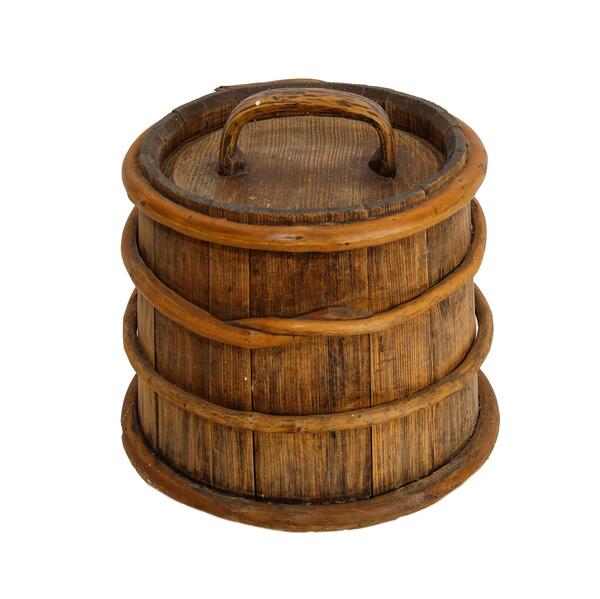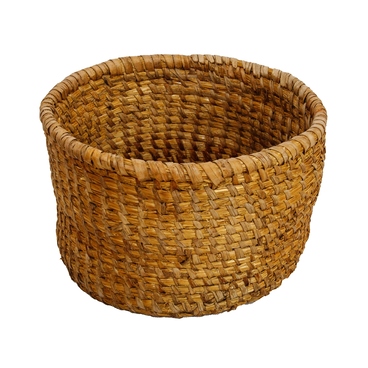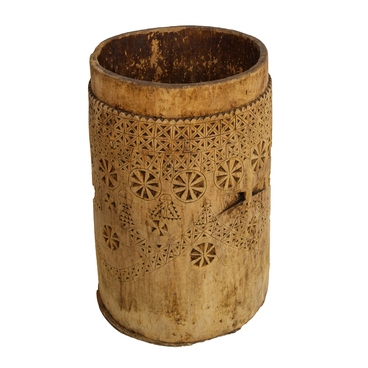This double-bottomed tub was purchased in the village of Nikolaevka, Lukoyanov district, Gorky region, by Vladimir Martyanov, an employee of the Mordovian Research Institute of Language, Literature, History and Ethnography. According to a local resident, the tub was brought to Nikolaevka from the village of Atingeeva, Lukoyanov district, which is located nearby. In 1970 it was bought for the collection of the museum.
Such tubs for storing water and kvass in the period of field work were called “lazovka”. Cylindrical, double-bottom lazovka is assembled from 15 staves. The bottoms are inserted into the slots. The handle is inserted into the upper end of the bent staple-shaped bast — the fibrous inner part of the bark of linden and some other deciduous trees. At the same place, near the wall, there is a hole for water drainage with a diameter of 2 centimeters. The tub is tightly closed and girded with four wooden hoops, twisted at the ends “in a lock”.
The lazovka was used for storing and carrying liquids. They could contain about a bucket of water or even more. They were taken to the distant hayfields, to the woods when cutting firewood, to the neighboring town to the fair. While traveling such a tub was hung on to a wagon or cart.
The first cooperage woodware appeared in ancient times. Archaeologists found the remains of such vessels in cultural layers dated back to the 8-10 centuries on the site of Old Ladoga. Based on the excavations of ancient Novgorod scientists learned a lot about the development level of cooperage craft in Russia in 10-15 centuries. Archaeologists reconstructed the dishes of that time from the found parts: hoops, staves and bottoms. After the reconstruction it became clear that the people of Novgorod in those centuries already used all the basic types of cooperage, which continued to be made in subsequent centuries.
In the Mordovian region cooperage craft appeared in the second half of the 17th century due to the development of production of potash (potassium-rich salt), resin and tar. Already by the end of the century more than 1000 barrels of potash were produced at 20 Potash Garths (special plants). Containers were needed to store it, so cooperage barrel makers worked to produce them.
Such tubs for storing water and kvass in the period of field work were called “lazovka”. Cylindrical, double-bottom lazovka is assembled from 15 staves. The bottoms are inserted into the slots. The handle is inserted into the upper end of the bent staple-shaped bast — the fibrous inner part of the bark of linden and some other deciduous trees. At the same place, near the wall, there is a hole for water drainage with a diameter of 2 centimeters. The tub is tightly closed and girded with four wooden hoops, twisted at the ends “in a lock”.
The lazovka was used for storing and carrying liquids. They could contain about a bucket of water or even more. They were taken to the distant hayfields, to the woods when cutting firewood, to the neighboring town to the fair. While traveling such a tub was hung on to a wagon or cart.
The first cooperage woodware appeared in ancient times. Archaeologists found the remains of such vessels in cultural layers dated back to the 8-10 centuries on the site of Old Ladoga. Based on the excavations of ancient Novgorod scientists learned a lot about the development level of cooperage craft in Russia in 10-15 centuries. Archaeologists reconstructed the dishes of that time from the found parts: hoops, staves and bottoms. After the reconstruction it became clear that the people of Novgorod in those centuries already used all the basic types of cooperage, which continued to be made in subsequent centuries.
In the Mordovian region cooperage craft appeared in the second half of the 17th century due to the development of production of potash (potassium-rich salt), resin and tar. Already by the end of the century more than 1000 barrels of potash were produced at 20 Potash Garths (special plants). Containers were needed to store it, so cooperage barrel makers worked to produce them.



